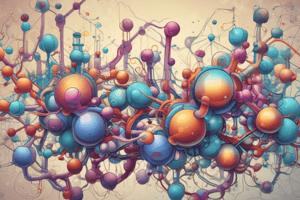Podcast
Questions and Answers
Which amino acid can form disulfide bonds due to its sulfhydryl group?
Which amino acid can form disulfide bonds due to its sulfhydryl group?
- Lysine
- Cysteine (correct)
- Alanine
- Arginine
At physiological pH (7.4), which form of an amino acid predominantly exists?
At physiological pH (7.4), which form of an amino acid predominantly exists?
- Cationic form
- Zwitterionic form (correct)
- Anionic form
- Protonated form
Which of the following amino acids does NOT have an ionizable side chain?
Which of the following amino acids does NOT have an ionizable side chain?
- Alanine (correct)
- Lysine
- Aspartic Acid
- Histidine
Which amino acids have three acid-base groups due to their ionizable side chains?
Which amino acids have three acid-base groups due to their ionizable side chains?
What happens to the charge of an amino acid when the pH changes?
What happens to the charge of an amino acid when the pH changes?
Which category do amino acids with side chains that are non-polar belong to?
Which category do amino acids with side chains that are non-polar belong to?
Which amino acids absorb UV light?
Which amino acids absorb UV light?
Who was a leader in the field of bioinformatics that developed the single letter code for amino acids?
Who was a leader in the field of bioinformatics that developed the single letter code for amino acids?
Which of the following amino acids has a unique first letter in its name?
Which of the following amino acids has a unique first letter in its name?
Which letter corresponds to the amino acid Asparagine in the single letter code?
Which letter corresponds to the amino acid Asparagine in the single letter code?
Which of these amino acids was assigned the letter 'E' in the single letter code?
Which of these amino acids was assigned the letter 'E' in the single letter code?
Which amino acid is known for having a phonetically suggestive name and corresponds to the code 'F'?
Which amino acid is known for having a phonetically suggestive name and corresponds to the code 'F'?
What property do all amino acids share concerning light absorption?
What property do all amino acids share concerning light absorption?
What is one consequence of chirality in drug effectiveness?
What is one consequence of chirality in drug effectiveness?
What is a typical result when amino acids are synthesized in the lab?
What is a typical result when amino acids are synthesized in the lab?
How does chirality influence enzyme reactions?
How does chirality influence enzyme reactions?
Which of the following statements about chiral pesticides is true?
Which of the following statements about chiral pesticides is true?
What is the typical configuration of amino acids found in proteins?
What is the typical configuration of amino acids found in proteins?
How do chiral compounds affect sensory properties like taste and smell?
How do chiral compounds affect sensory properties like taste and smell?
What role does chirality play in the optical properties of molecules?
What role does chirality play in the optical properties of molecules?
Which of the following statements is true regarding the chirality of amino acids?
Which of the following statements is true regarding the chirality of amino acids?
Study Notes
Stereochemistry of Amino Acids
- Chirality affects many properties and behaviors of molecules.
- One enantiomer of a chiral molecule is usually more active than the other.
- Enzymes are chiral and interact with only one enantiomer of a substrate.
- The effectiveness of pesticides and herbicides can differ between enantiomers.
- The smell and taste of chiral compounds can differ between enantiomers.
- Chiral molecules can affect the optical properties of materials.
- In biochemistry, the chirality of amino acids is not usually a critical point.
- Amino acids in proteins are usually of the L configuration.
- Some bacteria peptides have D amino acids, making them resistant to enzymatic attack.
- Biosynthetic processes produce pure stereoisomers.
Classification of Amino Acids
- The R group (side chain) determines the amino acid's characteristics.
- Amino acids are categorized into:
- Non-polar (hydrophobic)
- Polar (hydrophilic), uncharged
- Polar (hydrophilic), charged (positive or negative)
Spectroscopic Properties of Amino Acids
- All amino acids absorb light in the infrared region.
- Tyrosine, Tryptophan, and Phenylalanine absorb UV light.
- Phenylalanine absorbs UV light to a lesser degree than the other two.
Single-Letter Code for Amino Acids
- Developed by Dr. Margaret Dayhoff to shorten protein sequence files for computers.
- Six amino acids have unique first letters, making the code simple:
- Cysteine (Cys): C
- Histidine (His): H
- Isoleucine (Ile): I
- Methionine (Met): M
- Serine (Ser): S
- Valine (Val): V
- Other amino acids with the same first letter were assigned based on frequency in proteins.
- Some single-letter codes are phonetically suggestive.
Modified Amino Acids
- 20 amino acids are encoded in DNA and incorporated directly into proteins.
- Some amino acids can be chemically modified after being assembled into proteins.
- The cysteine sulfhydryl group (–SH) allows for disulfide bond formation.
Ionizable Groups in Amino Acids
- Amino acids can ionize, meaning their charge can change with pH.
- Amino acids are weak acids, possessing at least two acid-base groups:
- -carboxyl group
- -amino group
- Some amino acids have ionizable side chains (R groups) and three acid-base groups:
- Lysine
- Arginine
- Histidine
- Glutamic Acid
- Aspartic Acid
- Cysteine
- Tyrosine
- At physiological pH (7.4), amino acids exist in their zwitterionic form.
- The charge of an amino acid changes with pH.
- Alanine lacks an ionizable side chain, so its charge is determined by the amino and carboxyl groups.
Studying That Suits You
Use AI to generate personalized quizzes and flashcards to suit your learning preferences.
Related Documents
Description
Explore the fascinating world of amino acids by understanding their stereochemistry and classification. This quiz delves into concepts like chirality, enzyme interaction with enantiomers, and the various categories of amino acids based on their side chains. Test your knowledge on how these features influence biological processes and characteristics.




